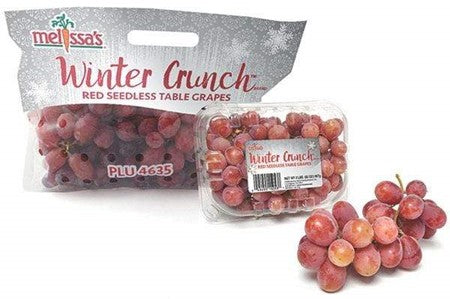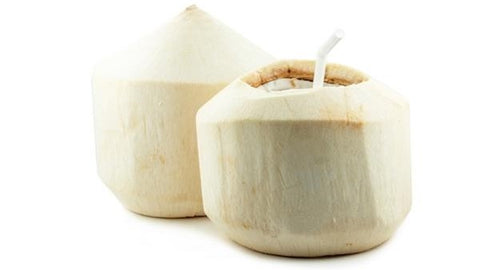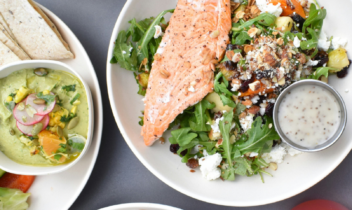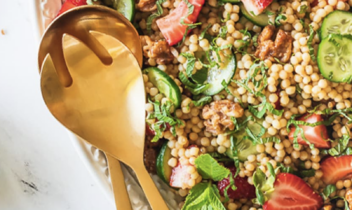
What fruits are in season in the fall around the world?
Answer

Dragon Fruit
Dragon fruit comes from the cactus plant; this tropical fruit is magenta and brilliant green on the outside, with the inner edible flesh ranging from white to hot pink! Dragon Fruit is very juicy with tiny, edible black seeds (like the ones found in kiwi) and tastes like a cross between watermelon, cactus pear, and kiwi. They are absolutely delicious and look very unique.
Dragon fruit is perfect for drinks: add to smoothies, use as a garnish or eat out-of-hand. They are low-calorie and thirst-quenching. Store in the refrigerator and eat chilled for the best flavor.

Tai Nung Papayas
These beautiful, yellow-spotted green papayas are full-flavored with delicious juicy flesh. Papayas are high in vitamin C and are a delicious and nutritious snack—to make a quick breakfast, cut and cube for fresh fruit salad, or try them blended into smoothies.

Green Dragon® Apples
In Chinese culture, the dragon is a symbol of royalty, hence the name of this apple. Green Dragon® Apples are highly prized and sought after and have become the ‘dragon’ of apples. These apples look like a green Golden Delicious with white crisp-textured flesh, encased in skin that resists bruising. It is an Orin variety mixed with Mutsu and Shizuka apples from Japan. Green Dragon® Apples are a sweet apple with low acidity and an enticing aroma.
Eat these apples out-of-hand or use them in baking— perfect for holiday platters with caramel dip or cheese! Enjoy throughout December.
Apples are delicious as a snack, chopped and tossed into salads, or made into desserts. They are low-calorie, contain no fat or cholesterol, and are high in fiber and vitamin C.

Meyer Lemons
Meyer lemons are also referred to as a cooking lemon; they should not be confused with conventional lemons. Meyer Lemons are rounder in shape, have thinner skins, and often have an orange blush. Meyer Lemons are thought to be a cross between a lemon and an orange; they are sweet-tasting lemons that can be eaten whole, including the skin and seeds! This citrus has a nice tartness that gives a kick to everything you may use them in, and they are well suited for desserts because of their sweet flavor.

Green Muscato™ Grapes
Exclusively available from Melissa’s, Green Muscato™ table grapes are grown in the Central Valley, California, where an ideal Mediterranean-like climate helps produce our superb, delectable grapes. In this heavenly valley, our Muscato™ grow, ripen, and are picked at the optimal time to ensure unparalleled flavor.
Green Muscato™ grapes are perfect for back-to-school lunches and snacks. Great for fruit salads, parfaits, or just eating out-of-hand. Their season is July – September.

Winter Crunch® Grapes
This late-season red grape is crisp and juicy. Grown exclusively for Melissa’s, they are perfect for cheese plates, snacking, or garnishes.
Grown in California, Winter Crunch® grapes taste like none other — don’t miss them!

Buddha Hands “Freaky Fruit®”
Also known as fo-shou in China and bushukan in Japan, the impressive Buddha’s hand symbolizes happiness, longevity, and good fortune. This citrus gets its name from the long finger-like tendrils, which are all zest. This traditional temple offering and New Year’s gift is closely related to the lemon.
Buddha’s hand is often used as a decoration but also for its zest, which can be used in any recipe that calls for lemon zest. The fruit inside is not bitter and can be candied, dried, and coated in chocolate. They are available from October to February.

Asian Pears
Asian Pears taste very similar to a pear but resemble an apple, which is where the name “apple pear” was derived. A large variety of these pears are available today, making them available just about all year long. They are delicious eaten out-of-hand and are firm and crunchy with plenty of sweet juice. Asian pears are great on fruit platters, salads, pies, desserts, or wherever you would use an apple.
Most Asian pears will last about 30 to 60 days when refrigerated, but eating as soon as possible is always best. Store them in the refrigerator and wrapped carefully so they will not bruise. Most apple pears are hand-picked and individually wrapped to prevent bruising during shipping. Asian and Korean pears are both good sources of vitamin B and potassium. They are also low in calories (about 44 per 3 ounces), making them the perfect snack.

Sweet Young Coconuts
Sweet Young Coconuts are traditionally used for the sweet, delicious water it contains. It also offers a sweet pudding-like flesh that is delicious right out of the shell and can be used in fruit salads and custards. Check out our easy-open method to enjoy coconut water as a refreshing drink. Once done, enjoy the delicious flesh.
Sweet Young Coconuts are available year-round with a shelf-life of about two weeks when refrigerated.

Jackfruit
Melissa’s fresh jackfruit is one of the newest items in the marketplace. Jackfruit is the largest tree fruit grown; one fruit can grow to over 30 pounds! It is commonly grown in Southeast Asia as well as Mexico. Jackfruit has become popular in the vegetarian community for its hearty flesh and unique flavor.
Jackfruit needs special care when opening as it can be very sticky but well worth the mess. If you choose not to prepare jackfruit yourself, Melissa’s now offers a prepared tray of jackfruit pods, just the good stuff. Give it a try!

Rambutans
This unusual-looking sub-tropical fruit contains a white grape-like fruit with a large seed. Remove the hairy-looking shell, remove the seed, and enjoy the tutti-frutti flavored flesh. They are a great snack, containing nutrients like fiber; some even believe them helpful as an anti-cancer fruit. They are refreshing to enjoy anytime!

Kiwano Melons
Also known as the African horned melon, this fascinating piece of fruit contains a lime green, jelly-like interior with the texture of a cucumber. The taste is a subtle combination of cucumber, banana, melon, and lime. The outer shell is spiky golden-orange and is often used as a serving dish filled with fruit salad, dip, or other delicious fillings. Kiwano melons are also used to create exotic tropical drinks or delicious sauces for seafood, poultry, and vegetables.
Kiwano melons last for several weeks without refrigeration. Once they “give” to the touch, they are ripe and ready to eat. Do not store them near apples or bananas, as these fruits will shorten their shelf-life. They are low in calories, with only 24 calories in 3 1/2 ounces and contain more potassium than a banana. They are also high in vitamin C.

Persimmons
Persimmons are thought to have Chinese origin, although today, they are also grown in Japan, Korea, Israel and the United States. There are many varieties of persimmons, with the most familiar being the Fuyu and the Hachiya. The Fuyu persimmon is flat and looks similar to an orange tomato. The Hachiya is also orange but has a heart shape. The Fuyu is generally eaten like an apple, while it is firm and crunchy, and the Hachiya is eaten when it is soft and juicy. Another variety is called the Cinnamon Persimmon; this variety of Fuyu is available for a limited time in the fall. They get their name because they appear to be speckled with cinnamon. In Spain, there is a variety called Sharon Fruit, which is more like the Fuyu variety.
Purchase persimmons with no bruises and generally firm. Store at room temperature until ripe and refrigerate once ripened (Fuyu persimmons may be eaten when firm). They are great dried and puréed into sauces for desserts, seafood or poultry. They are also great for holiday meals and decorations, too.

Pomegranates
The word pomegranate is Latin for “apple of numerous seeds.” Pomegranates probably originated around Persia and have been cultivated worldwide for thousands of years. There are even records of pomegranates being buried in Egyptian tombs, dating back thousands of years. Did you know that pomegranates are a Greek symbol of fertility? These beautiful red fruits have also been used for medicinal purposes and dying fabric. Today, they are eaten as a sweet and delicious treat whenever they are in season.
Pomegranates are generally chosen for size; the larger the fruit, the sweeter it will be. They are best when eaten at room temperature but can be refrigerated to prolong the shelf life. Pomegranate juice and seeds can be frozen for later use. Use pomegranate seeds in fruit salads as a garnish on plates, sorbets, desserts, or juices.

Starfruit
Starfruit originated in Southeast Asia or India thousands of years ago and has been gaining popularity ever since. Most of the starfruit in the United States is grown in Florida, but Taiwan is also a huge exporter. Melissa’s imports starfruit from Taiwan because of its superior quality and size. Most US-grown starfruit is about 4 to 6 inches long, while starfruit from Taiwan is about 6 to 8 inches long.
Starfruit, also known as Carambola, gets its name from its shape when cut widthwise. It has a waxy appearance; once the tiny seeds are removed, it is entirely edible. Most starfruit has a sweet-tart flavor. Starfruit is a tropical fruit with many uses; it is great sliced in salads, as a garnish for drinks or platters, served on meats, made into chutneys, and more. Always look for starfruit with no bruises; however, slight browning on the edges of the ribs is normal (some say this is sugar) and means the fruit is ripe. Starfruit will ripen at room temperature, from lime green to golden yellow (with brown edges). Eat immediately when ripe to enjoy the crispness of the fruit.

Cherimoyas
Also called Custard Apple or Custard Fruit, this delicious heart-shaped fruit is a delicacy in the exotic fruit group. They are a hand-pollinated fruit, which makes them a time-consuming commercial crop. However, supply is not a problem since they are grown in so many areas. The flesh of the cherimoya is cream-colored with large, black, inedible seeds. They have a flavor similar to a blend of strawberry, mango, and pineapple. To eat one, cut it into wedges and spoon the creamy flesh while discarding the seeds. They are generally eaten as-is, but they can be used in drinks, fruit salads, or desserts.
Cherimoyas should be kept at room temperature until ready to eat and can be stored in the refrigerator once ripe for a few days.


